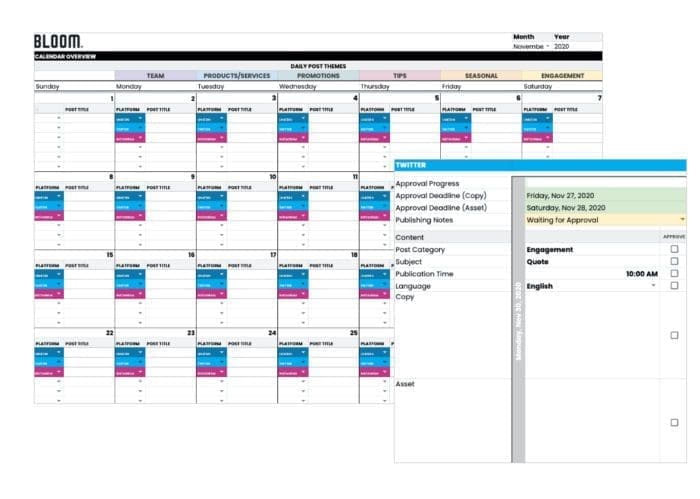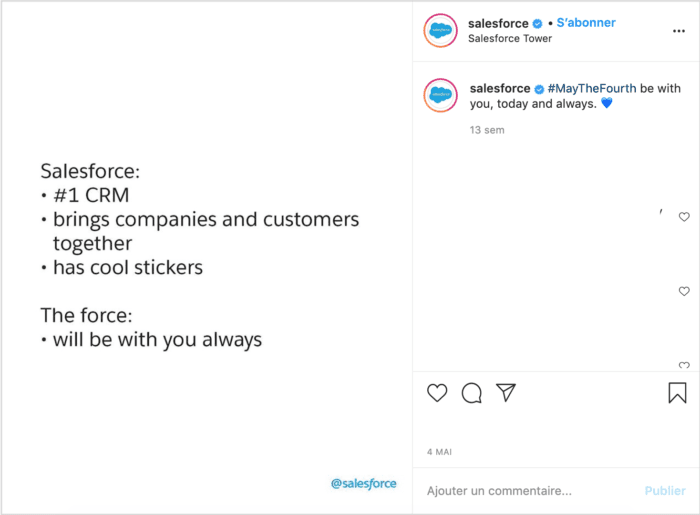Planning a digital marketing roadmap is essential for your digital strategy. The planning phase is key to implement an effective marketing strategy and achieve your business goals. When it comes to social media networks, marketers tend to put the planning aside and publish content as they come up with new ideas.
Publishing content without a well-thought-out editorial calendar often means being inconsistent and lacking coherence.
So, what is a content calendar? It’s an organizational tool that will help you plan your content and ensure uniformity in the frequency of your publications on your social media platforms.
Prior to creating an content calendar, several steps must be completed:
- Define different types of audience (generally between 2 to 5 personas) to understand their needs and expectations in order to provide content that will capture their interest;
- Analyze the current social media KPIs to identify trends and see what type of content hasn’t lived up to your expectations;
- Define your social media objectives (i.e.: brand awareness, website traffic, conversion, etc.).
Once you’ve covered the points mentioned above, follow these 5 steps to create an effective and powerful content calendar for your brand:
1. Create Your Content Calendar Template
To create your content calendar, you can use a spreadsheet such as Excel or Google Sheets (makes it easier to collaborate), or planning tools like Hootsuite or Trello.
You can choose to create a calendar for the entire year, a quarter or a month. A monthly social media calendar makes it easier to stay relevant and create content based on news and trends.
We also recommend that you create a specific calendar for each social media platform (LinkedIn, Facebook, Instagram, TikTok, etc.)
Social Media Calendar Example
At Bloom, we have created our own social media calendar template to meet our needs and those of our clients. The first page provides a monthly overview, while the second page presents, in detail, each publication (subject, time of publication, approval tracking, visual support, text, etc.).

2. Identify Important Dates Or Holidays
A low hanging fruit: once you’ve created your social media calendar’s skeleton, you should add events and holidays that are relevant to your industry.
These may include, for example:
- National holidays and celebrations
- School holidays
- International days
Get inspired! Here are a few examples of companies that have created social media content around an event or a special holiday:
Salesforce and Star Wars Day (May The Fourth)

Dynamite and Social Media Day

David’s tea and National Mojito Day

American Eagle and Emoji Day

IBM and Halloween

You can also list events specific to your company that shouldn’t go unnoticed, for example :
- Launch of a new product or service
- Attending a conference
- Your Company’s Anniversary
- Special Promotions
3. Define Themes For Each Social Posts
Creating only promotional content on your social networks would be counterproductive. Your posts should alternate between promotional content, entertaining content and informative content. To achieve your objectives and diversify your content, we recommend that you define 4 to 5 themes that are consistent with your market. For example:
- Team: Presenting content related to your team and your company’s “behind-the-scenes” is often popular on social media. Plus, it shows your company’s culture and human side which can create a stronger relationship with your potential customers or clients.
- Products / Services: This theme will allow you to highlight content that is directly promotional or informative about a product or your service.
- Events : These reference the events you have listed during the previous stage (Mother’s Day, New Year’s Eve, special conferences, etc.).
- Engagement: These will contain a clear call to action inviting the audience to respond to a question or survey, for example.
If you find it difficult to define the themes that make sense for your business, sit down with your sales team and client services team. They usually have great insights about what your potential customers are looking for and what type of content would be relevant to them.
4. Create A List of Interesting Social Media Topics
Having defined key themes will help you come up with topic ideas for your next social media posts. These topics should tie in with your buyer’s journey: discovery, consideration, action.
A prospect who doesn’t know your company won’t be looking for that same content than someone who’s really close to buying your product.
By creating various content geared toward a variety of audiences you’ll most likely create useful content, no matter where your prospects are in their buying process.
You can choose to alternate content or focus on a specific buying process step during a whole week for example.
5. Write Your Social Media Content
At this stage, you are finally ready to start writing! Your social media calendar should include:
- The type of content (photos, videos, carousel, etc.)
- The theme of each post (engagement, team, etc.)
- The objective of each post (conversion, brand awareness, etc.)
- The date and time of publication
- A link to your site, if you wish to direct the user to a specific page of your site, for example a blog article
- The creative or a description of the creative that will be used
Planning your social media posts with an content calendar will allow you to be more coherent and work towards a specific goal. You will also maintain a regular social media presence which usually helps acquire new clients, grow brand awareness and convert potential clients.
Need help? Our social media experts can create a successful social media strategy for your brand. Learn more here.
Subscribe to The Shift Factor
Our newsletter keeps you in the know on marketing’s biggest shifts and real examples of brands adapting.




Share this: